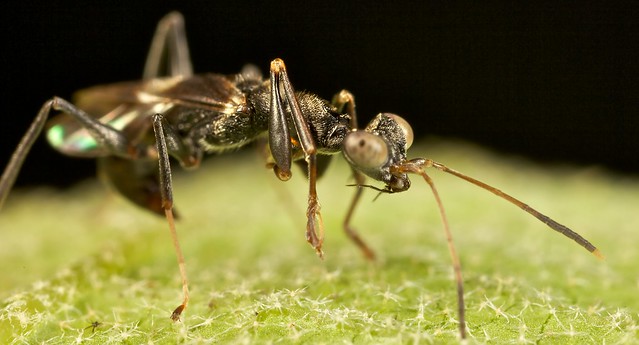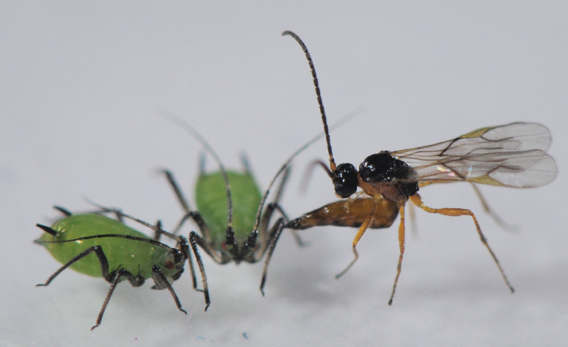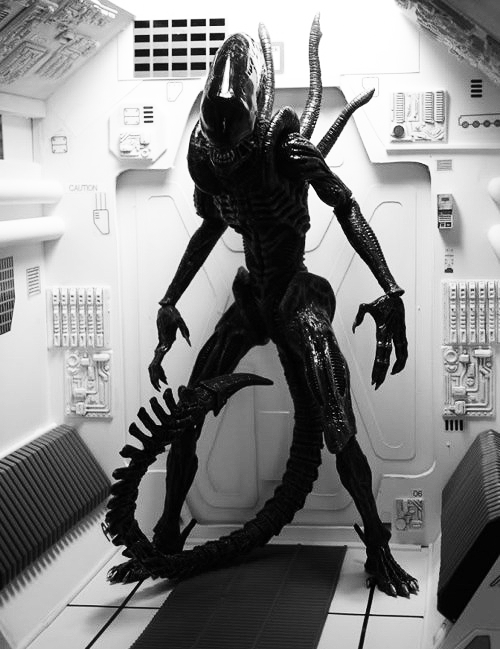 |
| A parasitoid wasp. |
Our planet is teeming with life, from the smallest microorganisms to the gigantic whales inhabiting the oceans. Provided with millions of years and a favourable enviornment, evolution has produced incredible and often bizzare organisms that look more like a product of science fiction than a real part of the nature we claim to know and understand.
I would like to introduce to you a creature that has captured my interest since early childhood, a creature that still holds mysteries that even the brightest minds can only wish to unravel. Usually no bigger than a few millimeters, this creature has succeeded into acomplishing tasks that most would consider impossible or higly unlikely. This animal is known as parasitoid wasps.
 |
| Ovipositing in an aphid. |
But wat is a parasitoid? Is it a parasite? Well not quite, a parasitoid is a creature that spends a significant portion of it's life cycle on or inside a certain host and unlike most parasites it eventually kills and usually consumes it's host.
Many organisms are parasitoids but some arthropods, especially insects, have reached astonishing feats as parasitoids. One specific group of animals have become the experts in this field. Most people think of wasps as social animals quite similar to bees but the fact is that the majority of wasps are solitary creatures that parasitise on other animals. Usually they are so small that are unnoticable with the naked eye. So what can be so fascinating about these little wasps?
First of all their life cycle is worthy of a horror movie.
The adult wasp finds it's host by different means depending on the species, in some cases the plants that are attacked by a caterpillar release chemicals that attract the exact species that use the caterpillar as a host! What follows is the wasp inserting it's ovipositor into the host and injecting it's eggs inside it.
As seen here:
Usually the host’s immune system should be enough to irradicate the eggs but the wasp has yet another amazing trick, polydnavirus!
What is polydnavirus (PDV)?
In a few words, millions of years ago parasitoid wasps assimilated a virus to use against their host’s immune system, keeping the eggs intact.
The next step of their life cycle is simple, the eggs hatch and the newly born larvae start to feed on their host’s fluids and non-vital organs keeping it alive throughout the whole process until the time they have to break out.
This video shows that stage of their development:
As you may have noticed after watching the video, in some cases the host remains alive after the wasp larvae leave it’s body. Here is where the most amazing ability of the parasitoid wasps can be seen! The heavily injured host protects the same larvae that fed on it’s organs and eventually broke out. Recent research has shown that one or two larvae remain inside the host controlling it into protecting the rest of the larvae, how this is achieved and how it is decided on which larvae to stay inside is still uknown.
Another video that shows the zombified host being controlled by the wasp larvae:
Truly remarkable creatures!
 |
| Fairyfly, the smallest known insect. |
The tiniest known insect to man is also a parasitoid wasp that parasitises other insects eggs. They are 0.139 mm (139 μm) in length and posses a fully functional brain capable of complex processing.
There are also species of parasitoid wasps that parasitise on spiders making them create a chaotic web rather than the well-organised web we are used to expect.
And ofcourse the more known jewel wasp that is famous for it’s ability to sting inside the cockroach’s brain in the precise point to turn it into a helpless slave that is later dragged by the antennae inside a nest where it will provide food for the wasp’s young.
 | |
| A comic explaining the jewel wasp's life cycle. |
 |
| The young jewel wasp emerging from her cockroach host. |
Really I can go all day and night writing and talking about how amazing parasitoid wasps are and if you don’t think the same way after reading the facts then don’t expect anything in nature to ever surprise you more than this.
I thank those who had the patience to read all the information and watch the videos I had to provide. I really hope you enjoyed it and that it opened your eyes to a world where the impossible is often proved possible by the most unnoticable and truly alien creatures.
Bonus material:
 |
| The Xenomorph standing upwards. |
If it hasn’t crossed your mind until now the life cycle of the famous Xenomorph creatures from the Alien series is inspired by parasitoid wasps as well as other insects. This analysis provides enough information on the subject coming from the actual creators of the Alien concept.
Bonus video:
I came across a really detailed video of parasitoid wasps emerging from their unfortunate host that I would like to share.
I must warn you it’s really not for the faint of heart!


Няма коментари:
Публикуване на коментар